My Humble Opinion: The Way Most Golf Teachers Should Be Teaching
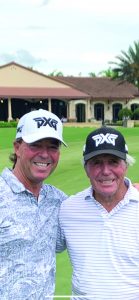 By Wayne Player, USGTF Member, Tequesta, Florida
Firstly, if you continue to do what you’ve always done, then you will continue to get the results you’ve always gotten. Change is the price of
survival, without question. One must focus on athletic fundamentals around power, balance and repetition.
My personal experience as a professional golfer and son of a golfing legend, Gary Player, led me to create a more simplified approach to
the game in The Player Approach. I have had more access to golf gurus, legends and sports psychologists than maybe anyone. You name
them, and I spent my dad’s money there as a young man. There are so many golfing teacher gurus out there that the golf world seems to be
inundated with a bunch of instructional malarkey. So, who is the guru of the gurus? I don’t know.
I would urge all of you to believe in a more simplified, four-pronged approach to eliminate paralyses of analysis:
1) a flat front foot/lead foot,
2) how to become a true front-foot hitter,
3) athleticism, and
4) a positive attitude.
Please see the next page for a greeting for Mr. Brandon Lee, president and CEO of the USGTF.
By Wayne Player, USGTF Member, Tequesta, Florida
Firstly, if you continue to do what you’ve always done, then you will continue to get the results you’ve always gotten. Change is the price of
survival, without question. One must focus on athletic fundamentals around power, balance and repetition.
My personal experience as a professional golfer and son of a golfing legend, Gary Player, led me to create a more simplified approach to
the game in The Player Approach. I have had more access to golf gurus, legends and sports psychologists than maybe anyone. You name
them, and I spent my dad’s money there as a young man. There are so many golfing teacher gurus out there that the golf world seems to be
inundated with a bunch of instructional malarkey. So, who is the guru of the gurus? I don’t know.
I would urge all of you to believe in a more simplified, four-pronged approach to eliminate paralyses of analysis:
1) a flat front foot/lead foot,
2) how to become a true front-foot hitter,
3) athleticism, and
4) a positive attitude.
Please see the next page for a greeting for Mr. Brandon Lee, president and CEO of the USGTF.
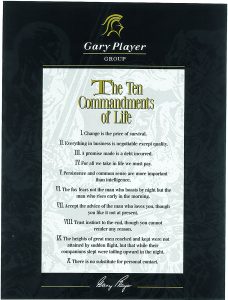 Dear Mr Lee,
We are all excited in welcoming you as the new owner and president of the USGTF. While Geoff Bryant certainly created an incredible
platform and service for golf teachers, we know that you will take the USGTF to great and exciting new horizons. A few of my dad Gary
Player’s commandments of life are: There is no substitute for personal contact; everything in business is negotiable except quality, and a
promise made is a debt incurred. There is no doubt that Mr Lee is an honorable and good man, and present members of the USGTF
should know that they are in great hands going forward.
I personally am looking forward to continue to work closely with you and your USGTF team in bringing new innovative ideas and products that we will offer all the existing members to assist them in becoming better teachers and mentors to their clients. We strongly believe in
your leadership and what the USGTF means to the golf teaching industry. Teaching and coaching the game of golf to those interested in learning and improving is a valuable and honorable profession. The game is always a healthy outlet for anyone, and the Player family is well known for valuing a healthy lifestyle and activities. Golf has given much to us, and we are pleased to see the USGTF giving so much to the game. Again, we look forward to working with you and wish you the best moving forward.
Sincerely,
Wayne Gary Player
Dear Mr Lee,
We are all excited in welcoming you as the new owner and president of the USGTF. While Geoff Bryant certainly created an incredible
platform and service for golf teachers, we know that you will take the USGTF to great and exciting new horizons. A few of my dad Gary
Player’s commandments of life are: There is no substitute for personal contact; everything in business is negotiable except quality, and a
promise made is a debt incurred. There is no doubt that Mr Lee is an honorable and good man, and present members of the USGTF
should know that they are in great hands going forward.
I personally am looking forward to continue to work closely with you and your USGTF team in bringing new innovative ideas and products that we will offer all the existing members to assist them in becoming better teachers and mentors to their clients. We strongly believe in
your leadership and what the USGTF means to the golf teaching industry. Teaching and coaching the game of golf to those interested in learning and improving is a valuable and honorable profession. The game is always a healthy outlet for anyone, and the Player family is well known for valuing a healthy lifestyle and activities. Golf has given much to us, and we are pleased to see the USGTF giving so much to the game. Again, we look forward to working with you and wish you the best moving forward.
Sincerely,
Wayne Gary Player


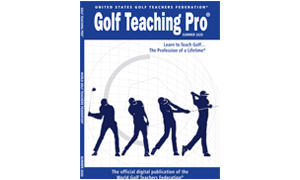
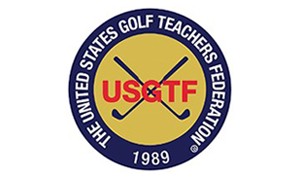
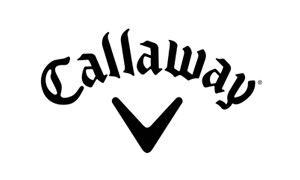

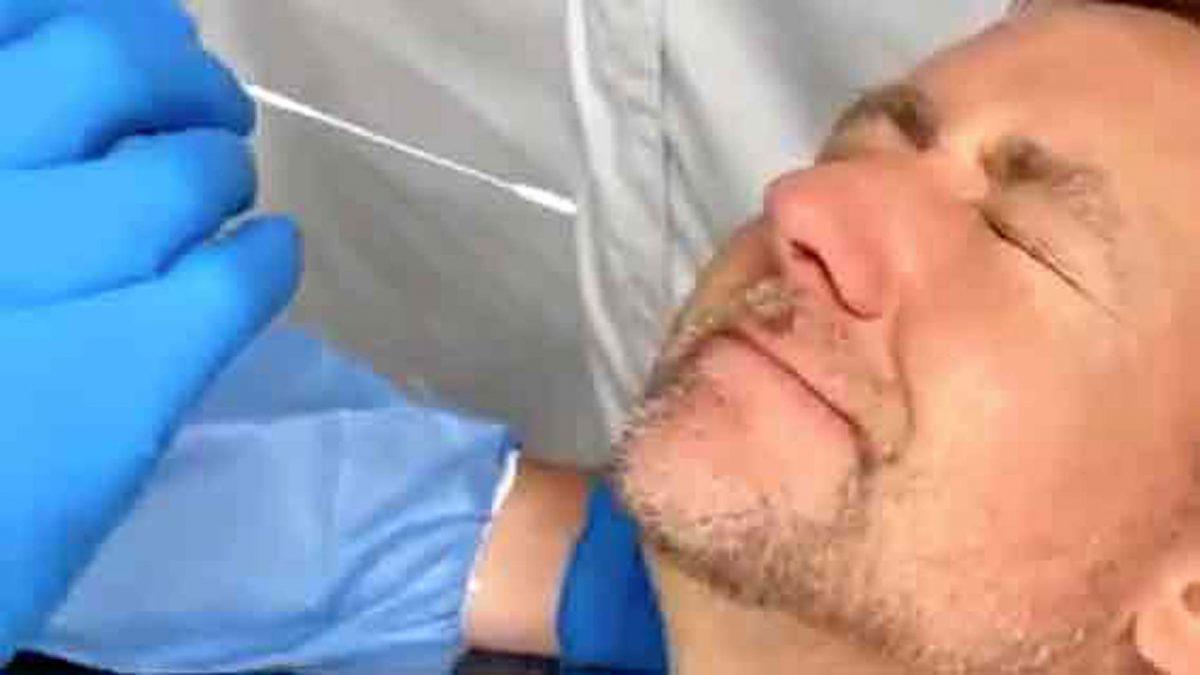


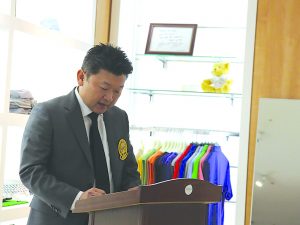 For 31 years, one man led the USGTF as its president and CEO. That would be founder Geoff Bryant, who in 1989 started a revolution in the golf teaching business that continues strong to this day.
Recently, Bryant said 31 years is enough and it’s time to ride off into retirement. Enter Brandon Lee, who assumed the titles of president and CEO in February. Lee was formerly the director of the USGTF’s foreign language courses and president of USGTF-Korea, among other entities. He also served as vice president of the World Golf Teachers Federation, the umbrella group that is comprised of more than 40 member nations.
Lee was born in South Korea and grew up there. As a kid, he participated in many sports due to the influence of his father. Lee’s dad also got him involved in golf in high school. He later completed his Ph.D in Exercise Biochemistry in Japan. After a career in that field, he came
to the United States and completed the USGTF certification program in 2005. He began his golf teaching career in Orange County, California,
in the cities of Irvine and Laguna Hills, where he operated a teaching academy.
His academy was extremely successful, the result of his business acumen and previous experiences, and this caught the attention of Bryant, who named Lee vice president of the USGTF in 2011. In that role, Lee established the USGTF’s foreign language courses (FLC), which were based on strong professional ethics and educational programs, while continuing to research and spread the latest golf teaching methods in the United States. This has helped foreigners in the United States earn USGTF certification and continue the organization’s progress as a leader in golf.
Here is a Q&A with the USGTF’s new president, Brandon Lee:
Q: Why did you want to become president/CEO of the USGTF?
A: The USGTF was started with a great mission envisioned by Geoff Bryant. I thought it was time for a new generation to continue the mission and continue the development. I worked through the ranks as a Certified Golf Teaching Professional, a Master Teaching Professional and FLC course director. It made sense to naturally progress into this role.
Q: What do you see as the USGTF’s future and what are your plans for it?
A: To make the USGTF certification more valuable by helping the members make money through teaching and employment, because the USGTF is a career choice. I also plan to work harder to define what a golf teaching professional is and does in the industry. Many in the golfing industry believe the USGTF is a secondary license below the PGA. I experienced the same problem when I started USGTF-Korea in 2016. But through my will and effort, the Korean golf industry moved to accept our status and our mission. As a result, they started to recognize USGTF is the best license to learn golf teaching methodology and KPGA members also started to join and learn our USGTF educational system.
Q: What do you see as one or more of the strengths of the USGTF?
A: With the slogan of “Learn to teach golf – the profession of a lifetime,” the USGTF provides an opportunity to challenge and inspire not
only existing professionals but also ordinary people who have a strong passion for golf. We have many golf enthusiasts, with diverse backgrounds, such as businessmen and retirees who are not golf professionals.
Q: In part, why has USGTF-Korea been so successful?
A: In Korea, the USGTF started as a minor player in golf. It is now composed of a large number of members from various professions who are not KPGA professionals. It is also a representative group for those who seek a second life through giving golf lessons. By promoting a
strong professional ethical sense of being a golf leader that combines teaching skills and developing the personalities of our teaching
professionals, it was able to grow into an organization that cultivates experts in teaching the game of golf.
Lee is committed to taking the USGTF to new heights as we are now well into the 21st century. His success with USGTF-Korea and the foreign language courses in the United States should bode well as the USGTF navigates its way in the ever-changing fields of golf instruction and golf business.
Lee has completed a move to Florida from California and oversees the daily operations of the USGTF from the national office, located in Fort Pierce, Florida. He welcomes member input and can be reached by email at president@usgtf.com.
For 31 years, one man led the USGTF as its president and CEO. That would be founder Geoff Bryant, who in 1989 started a revolution in the golf teaching business that continues strong to this day.
Recently, Bryant said 31 years is enough and it’s time to ride off into retirement. Enter Brandon Lee, who assumed the titles of president and CEO in February. Lee was formerly the director of the USGTF’s foreign language courses and president of USGTF-Korea, among other entities. He also served as vice president of the World Golf Teachers Federation, the umbrella group that is comprised of more than 40 member nations.
Lee was born in South Korea and grew up there. As a kid, he participated in many sports due to the influence of his father. Lee’s dad also got him involved in golf in high school. He later completed his Ph.D in Exercise Biochemistry in Japan. After a career in that field, he came
to the United States and completed the USGTF certification program in 2005. He began his golf teaching career in Orange County, California,
in the cities of Irvine and Laguna Hills, where he operated a teaching academy.
His academy was extremely successful, the result of his business acumen and previous experiences, and this caught the attention of Bryant, who named Lee vice president of the USGTF in 2011. In that role, Lee established the USGTF’s foreign language courses (FLC), which were based on strong professional ethics and educational programs, while continuing to research and spread the latest golf teaching methods in the United States. This has helped foreigners in the United States earn USGTF certification and continue the organization’s progress as a leader in golf.
Here is a Q&A with the USGTF’s new president, Brandon Lee:
Q: Why did you want to become president/CEO of the USGTF?
A: The USGTF was started with a great mission envisioned by Geoff Bryant. I thought it was time for a new generation to continue the mission and continue the development. I worked through the ranks as a Certified Golf Teaching Professional, a Master Teaching Professional and FLC course director. It made sense to naturally progress into this role.
Q: What do you see as the USGTF’s future and what are your plans for it?
A: To make the USGTF certification more valuable by helping the members make money through teaching and employment, because the USGTF is a career choice. I also plan to work harder to define what a golf teaching professional is and does in the industry. Many in the golfing industry believe the USGTF is a secondary license below the PGA. I experienced the same problem when I started USGTF-Korea in 2016. But through my will and effort, the Korean golf industry moved to accept our status and our mission. As a result, they started to recognize USGTF is the best license to learn golf teaching methodology and KPGA members also started to join and learn our USGTF educational system.
Q: What do you see as one or more of the strengths of the USGTF?
A: With the slogan of “Learn to teach golf – the profession of a lifetime,” the USGTF provides an opportunity to challenge and inspire not
only existing professionals but also ordinary people who have a strong passion for golf. We have many golf enthusiasts, with diverse backgrounds, such as businessmen and retirees who are not golf professionals.
Q: In part, why has USGTF-Korea been so successful?
A: In Korea, the USGTF started as a minor player in golf. It is now composed of a large number of members from various professions who are not KPGA professionals. It is also a representative group for those who seek a second life through giving golf lessons. By promoting a
strong professional ethical sense of being a golf leader that combines teaching skills and developing the personalities of our teaching
professionals, it was able to grow into an organization that cultivates experts in teaching the game of golf.
Lee is committed to taking the USGTF to new heights as we are now well into the 21st century. His success with USGTF-Korea and the foreign language courses in the United States should bode well as the USGTF navigates its way in the ever-changing fields of golf instruction and golf business.
Lee has completed a move to Florida from California and oversees the daily operations of the USGTF from the national office, located in Fort Pierce, Florida. He welcomes member input and can be reached by email at president@usgtf.com.
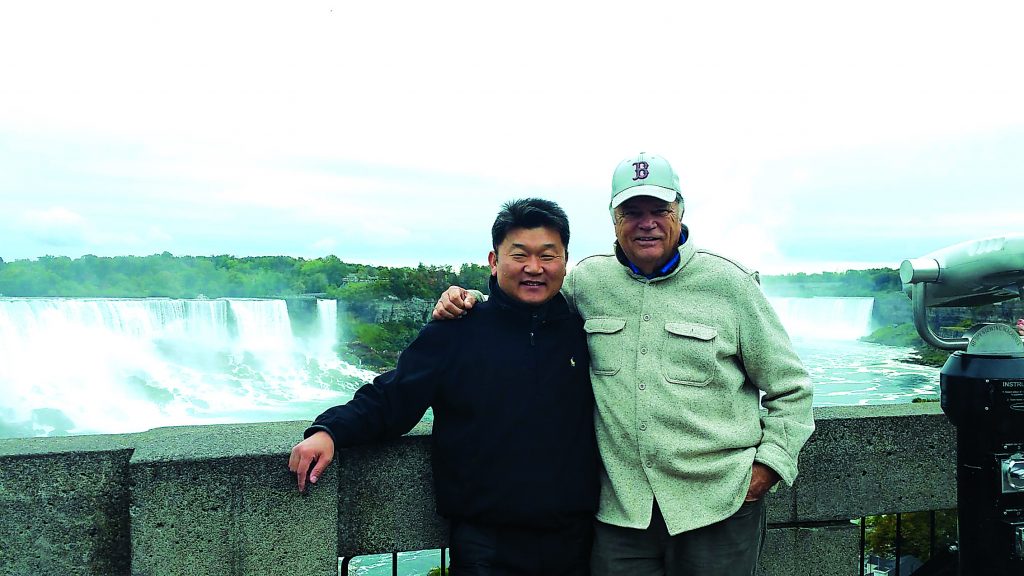
 The COVID-19 coronavirus has certainly turned our world upside-down. Multiple businesses were forced to closed, including golf courses, when most American governors mandated that “nonessential” businesses do so. A philosophical point can be made that there are no businesses that are non-essential, because all businesses are essential to the owners that own them, employees who depend on their paychecks and the customers who rely on the products and services those businesses provide.
Gatherings of over 10 people were also either discouraged or declared illegal as government officials moved into action to try to stop the spread of the coronavirus. That effectively ended professional sports in the United States for a considerable period of time, including golf on the PGA Tour. The first round of The Players was completed in March when the Tour decided that it was not feasible to continue play and wound up canceling the tournament. Other events were either canceled or postponed, as well.
After three months of being shut down, the PGA Tour started play again on June 11 at Colonial Country Club in Fort Worth, Texas, and going forward, the experience will certainly be different for players and fans alike. For one, there actually will be no fans for the first four events; not even players’ families will be allowed on-site. It takes approximately 2,500 people to make a PGA Tour event happen, but the Tour plans to try to run with around 1,000 extra personnel at the venue. Virus testing will not be possible for everyone due to logistics, but screenings and questionnaires will be the norm.
Caddies will be required to clean the flagsticks and bunker rakes after they handle them, and both players and caddies are expected to sanitize their hands after the playing of each hole. Players are encouraged to pull the clubs out of the bag and return them without the caddie touching them. Players are also going to be the only ones allowed to pick their ball out of the hole. Both players and caddies will be tested for the virus before each event, and any player returning a positive test will be forced to withdraw from the tournament. Masks will also be provided for any player, caddie and essential personnel at the course.
A charter plane will also be made available to players and caddies alike, and only those who test negative for the virus within 24 hours of departure will be allowed to board. Players and caddies are expected to all stay at the same hotel, basically sequestered there with no travel outside the hotel except to the golf course. This includes staying in the hotel for all meals and not going out to a restaurant to eat.
Frankly, while these guidelines seem reasonable to the extent that stopping the spread of the virus is the main focus, they ignore the realities of human behavior. Expecting touring professionals to never leave the hotel unless they are going to the golf course might work for a week or two, but undoubtedly most players will tire of this forced routine of boredom. If their families are not allowed to be with them at the course, you can be sure that many players will skip the post-round practice routines that are prevalent and head straight back to the hotel to be with their families. However, not being able to take the little ones to a park, playground, etc., might weigh on the minds of the players and their spouses, and we could see some players deciding to stay home until things return more to normal.
Expecting players and caddies to sanitize their hands and anything on the course they might touch seems a bit unreasonable, too. Golf is being played all across the country, and currently there are no reports of players falling ill from being at the course. Epidemiologists who have weighed in have said that golf is one of the safest possible activities to engage in, and that’s even with our former way of doing things. And it’s seriously doubtful that any player will be playing with any sort of mask or face covering, although it’s possible that you might see some of the more physically compromised caddies doing so. However, various health experts have said that contracting the environment in an outdoor setting is extremely unlikely, so it will be interesting to see how many people on our television screens will be wearing them.
What will happen when fans are eventually allowed to return? That’s anyone’s guess. If we see corporate hospitality tents, they almost certainly will be of limited capacity so the guests can maintain social distancing of six feet or more apart from each other. Bleachers may exist, but sections or seats may be cordoned off so people aren’t sitting less than six feet apart. But then again, we might not see any hospitality tents or bleachers. We’ll just have to wait and see what happens with the first few events where fans are allowed.
When will things return completely to “normal”? Again, that’s anyone’s guess. Current reports at the time of this writing say a vaccine is at least 18 months away (which would be late 2021), and maybe much longer than that. With the current emphasis having shifted from “flattening the curve” so hospitals didn’t get overrun to “let’s keep the number of cases as low as possible for as long as possible” until a vaccine is developed, it’s possible nothing resembling normalcy might not happen for years.
That would be most unfortunate, but given the vagaries of human behavior, combined with the fact that forcing people into artificial behaviors for an extended period of time are not likely to work, we could well see a sea of change in the way both ordinary citizens and our authority figures want to handle this. Also, with research from the Stanford University School of Medicine, the University of Southern California/Los Angeles County Department of Public Health, the University of Bonn in Germany and Oxford University in England, among others, showing the infection fatality rate of the virus isn’t nearly as severe as first thought, there are some encouraging signs that not only golf, but life in general, may return to normal sooner than we may think possible at present.
The COVID-19 coronavirus has certainly turned our world upside-down. Multiple businesses were forced to closed, including golf courses, when most American governors mandated that “nonessential” businesses do so. A philosophical point can be made that there are no businesses that are non-essential, because all businesses are essential to the owners that own them, employees who depend on their paychecks and the customers who rely on the products and services those businesses provide.
Gatherings of over 10 people were also either discouraged or declared illegal as government officials moved into action to try to stop the spread of the coronavirus. That effectively ended professional sports in the United States for a considerable period of time, including golf on the PGA Tour. The first round of The Players was completed in March when the Tour decided that it was not feasible to continue play and wound up canceling the tournament. Other events were either canceled or postponed, as well.
After three months of being shut down, the PGA Tour started play again on June 11 at Colonial Country Club in Fort Worth, Texas, and going forward, the experience will certainly be different for players and fans alike. For one, there actually will be no fans for the first four events; not even players’ families will be allowed on-site. It takes approximately 2,500 people to make a PGA Tour event happen, but the Tour plans to try to run with around 1,000 extra personnel at the venue. Virus testing will not be possible for everyone due to logistics, but screenings and questionnaires will be the norm.
Caddies will be required to clean the flagsticks and bunker rakes after they handle them, and both players and caddies are expected to sanitize their hands after the playing of each hole. Players are encouraged to pull the clubs out of the bag and return them without the caddie touching them. Players are also going to be the only ones allowed to pick their ball out of the hole. Both players and caddies will be tested for the virus before each event, and any player returning a positive test will be forced to withdraw from the tournament. Masks will also be provided for any player, caddie and essential personnel at the course.
A charter plane will also be made available to players and caddies alike, and only those who test negative for the virus within 24 hours of departure will be allowed to board. Players and caddies are expected to all stay at the same hotel, basically sequestered there with no travel outside the hotel except to the golf course. This includes staying in the hotel for all meals and not going out to a restaurant to eat.
Frankly, while these guidelines seem reasonable to the extent that stopping the spread of the virus is the main focus, they ignore the realities of human behavior. Expecting touring professionals to never leave the hotel unless they are going to the golf course might work for a week or two, but undoubtedly most players will tire of this forced routine of boredom. If their families are not allowed to be with them at the course, you can be sure that many players will skip the post-round practice routines that are prevalent and head straight back to the hotel to be with their families. However, not being able to take the little ones to a park, playground, etc., might weigh on the minds of the players and their spouses, and we could see some players deciding to stay home until things return more to normal.
Expecting players and caddies to sanitize their hands and anything on the course they might touch seems a bit unreasonable, too. Golf is being played all across the country, and currently there are no reports of players falling ill from being at the course. Epidemiologists who have weighed in have said that golf is one of the safest possible activities to engage in, and that’s even with our former way of doing things. And it’s seriously doubtful that any player will be playing with any sort of mask or face covering, although it’s possible that you might see some of the more physically compromised caddies doing so. However, various health experts have said that contracting the environment in an outdoor setting is extremely unlikely, so it will be interesting to see how many people on our television screens will be wearing them.
What will happen when fans are eventually allowed to return? That’s anyone’s guess. If we see corporate hospitality tents, they almost certainly will be of limited capacity so the guests can maintain social distancing of six feet or more apart from each other. Bleachers may exist, but sections or seats may be cordoned off so people aren’t sitting less than six feet apart. But then again, we might not see any hospitality tents or bleachers. We’ll just have to wait and see what happens with the first few events where fans are allowed.
When will things return completely to “normal”? Again, that’s anyone’s guess. Current reports at the time of this writing say a vaccine is at least 18 months away (which would be late 2021), and maybe much longer than that. With the current emphasis having shifted from “flattening the curve” so hospitals didn’t get overrun to “let’s keep the number of cases as low as possible for as long as possible” until a vaccine is developed, it’s possible nothing resembling normalcy might not happen for years.
That would be most unfortunate, but given the vagaries of human behavior, combined with the fact that forcing people into artificial behaviors for an extended period of time are not likely to work, we could well see a sea of change in the way both ordinary citizens and our authority figures want to handle this. Also, with research from the Stanford University School of Medicine, the University of Southern California/Los Angeles County Department of Public Health, the University of Bonn in Germany and Oxford University in England, among others, showing the infection fatality rate of the virus isn’t nearly as severe as first thought, there are some encouraging signs that not only golf, but life in general, may return to normal sooner than we may think possible at present.